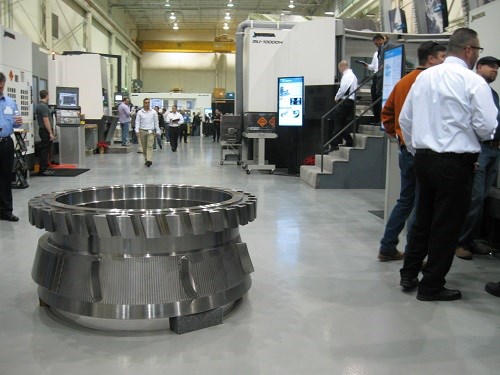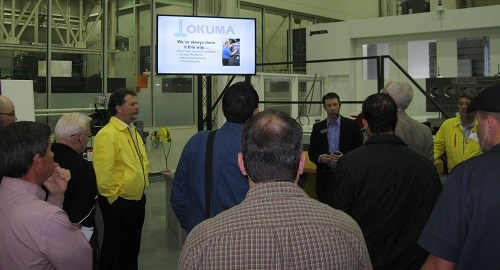The Case for Off-Site Innovation
Okuma says the point of its aerospace technology center is to provide a place for manufacturers to perform all the trial-and-error they need to perfect a new process. It’s also a place to find and consult with sources of up-to-date manufacturing technology expertise.
Share







Okuma wants to help its customers succeed. Part of that is helping them fail.
According to Wade Anderson, the company’s manager of technology centers, providing customers with “a place to fail” is a large part of the reason why the machine tool builder this year opened a new technology center devoted to . The company’s initial development partners in this new aerospace-focused facility include Sandvik Coromant and 5ME.
The 10,000-square-foot space at Okuma’s Charlotte, North Carolina, U.S. headquarters includes a range of machine tool types the makers of critical aircraft components are likely to employ, including large-travel five-axis machining centers and Y-axis live-tool lathes. For a manufacturer to commit its own in-house resources to developing and proving out a new machining process is often impractical, Mr. Anderson says, because no one can say how long the trial-and-error will take. This is particularly true in aerospace machining, which often involves materials that are difficult to cut and geometries that are difficult to achieve.
In fact, Mr. Anderson says it’s increasingly likely that the expertise for process innovation might not be available within a manufacturer’s own facility, either. The very nature of expertise has changed, he says. We see this at the level of our individual work and interests, where we no longer master information to the extent that someone might have done a generation ago, but instead we rely on online searches for the information we need as the need arises. Something similar is true at the level of manufacturing process innovation, he says. Technologies are advancing rapidly enough and interrelating to such an extent that, for a production manufacturer, trying to develop and maintain up-to-date manufacturing expertise might be a hopeless struggle. Better to rely on resources able to provide current knowledge as needed.
One of the center’s partners exemplifies this. 5ME is a manufacturing technology firm offering various tooling and shopfloor management technologies, as well as (perhaps most significantly) cryogenic machining. This is a technology still unknown or little known to many manufacturers, though it has the potential to benefit various processes involving machining aerospace alloys.
Meanwhile, Mr. Anderson observes that tooling technology has advanced to the point that previously accepted expectations about productive machining parameters are now in some cases far off-base. And machine tool capabilities have advanced to the point that even basic decisions such as whether a machining center or a turning machine is the right choice for a part might deserve to be reevaluated. Getting outside of the organization to encounter people thinking about these topics is valuable, particularly experts from different technology suppliers knowledgeable about different facets of these questions.
He says the aerospace center is a logical step forward for Okuma’s “Partners in THINC,” the affiliation of companies all offering technology complementary with Okuma’s THINC control. With now part of Partners in THINC, the range of potential technology solutions is vast but potentially daunting. In the aerospace center, by contrast, engaging partners on a project-by-project basis is part of maintaining the sole-industry focus of the center. If this works well, he believes it is likely that other industry-focused centers will follow.

Photos of the new aerospace tech center were taken at a recent open house, where Wade Anderson (seen here) was one of the presenters.
Related Content
Function Over Form
While the metalworking industry includes a wide variety of machine shops, it is worthwhile remembering that the differences obscure a key commonality: they all run on human ingenuity.
Read MoreHow a Custom ERP System Drives Automation in Large-Format Machining
Part of Major Tool’s 52,000 square-foot building expansion includes the installation of this new Waldrich Coburg Taurus 30 vertical machining center.
Read MoreHow to Meet Aerospace’s Material Challenges and More at IMTS
Succeeding in aerospace manufacturing requires high-performing processes paired with high-performance machine tools. IMTS can help you find both.
Read MoreRego-Fix Appoints New Global Aerospace Specialist
Sherman D’Souza will provide global customers with access to Rego-Fix research, development and technical support teams to create and supply toolholding solutions.
Read MoreRead Next
AMRs Are Moving Into Manufacturing: 4 Considerations for Implementation
AMRs can provide a flexible, easy-to-use automation platform so long as manufacturers choose a suitable task and prepare their facilities.
Read MoreMachine Shop MBA
Making Chips and Modern Machine Shop are teaming up for a new podcast series called Machine Shop MBA—designed to help manufacturers measure their success against the industry’s best. Through the lens of the Top Shops benchmarking program, the series explores the KPIs that set high-performing shops apart, from machine utilization and first-pass yield to employee engagement and revenue per employee.
Read More





















